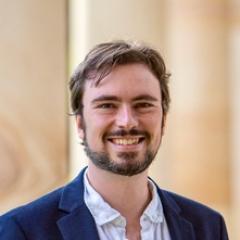Optical design and data analysis with automatic differentiation
Project level: Honours, PhD
Looking for a planet next to a star is like looking for a firefly next to a searchlight - a planet might be millions of times fainter if you're lucky, and the Earth would be billions of times fainter than the Sun to distant astronomers. The problem gets worse: if you shine a laser at a wall, you'll notice you get a big cloud of speckles around the central dot. The same thing happens looking at a star with a telescope: any optical distortions introduce clouds of speckles that spread starlight out over a wide area. Our pale blue dot would be completely washed out with stray light from the Sun, and a key challenge in astronomy is figuring out ways to manage and suppress starlight to see faint objects nearby.
Many optical instruments exist for doing this - for example coronagraphs and interferometers - but they are a challenge to design and implement. Alternatively, you can use plain old telescopes and try to correct the speckles in post-processing on a computer. This is going to be hugely important for the new ten-billion-dollar James Webb Space Telescope to fulfil its promises.
The key technology that underlies machine learning is automatic differentiation - you want to train a neural network with a million parameters, so you want to calculate exact derivatives of the loss function and use gradient descent. Thanks to the massive investment in machine learning from tech giants like Google, there are now software packages like TensorFlow and Jax that let you differentiate essentially any numerical functions you can write in (say) Python.
We can now use this to optimize optical systems by gradient descent - the shapes and sizes of mirrors, the patterns on phase plates, and many other things. We can also use the same software to help generate better post-processing corrections.
This is an opportunity for pretty open-ended, computationally-intensive PhD and Honours projects for students with an interest in machine learning, computer science, and high precision astronomy.
- Simulate and optimize coronagraphs
- Measure the warping of the Hubble Space Telescope from archival data
- Help better understand and commission the James Webb Space Telescope optics!
For further reading, see: Kernel phase and coronagraphy with automatic differentiation

